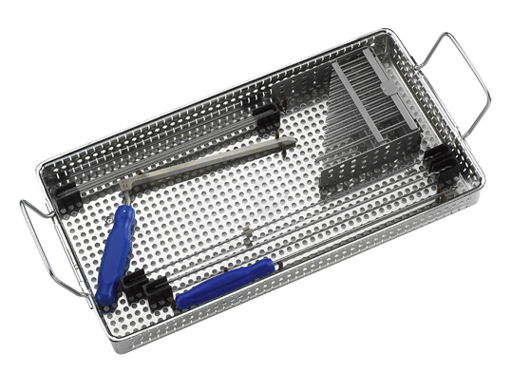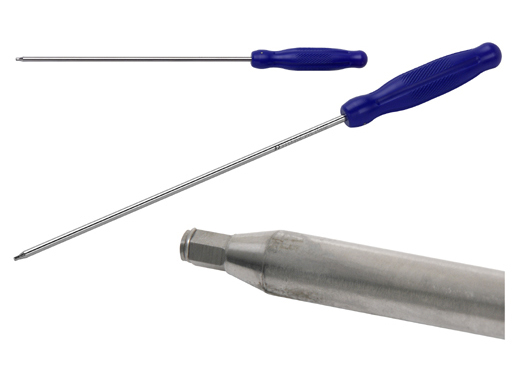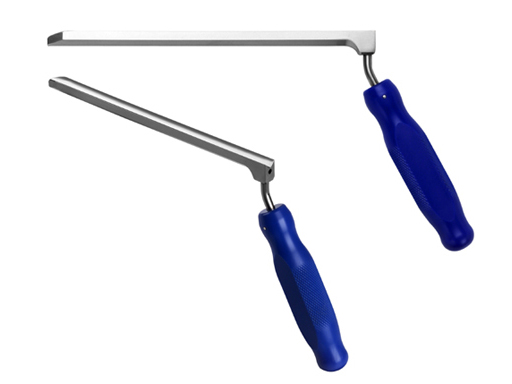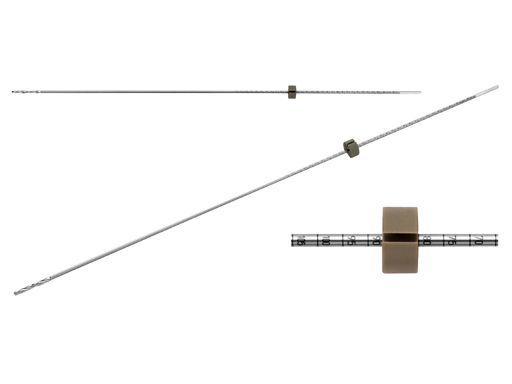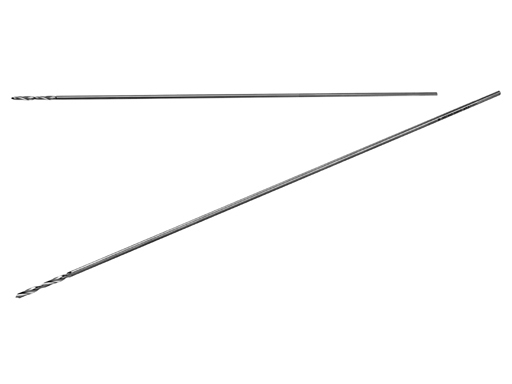
Percutaneous Guiding System
The Percutaneous Guiding System is a set of instruments that allows percutaneous placement of long screws in the pelvic area and other body regions. It allows easy and accurate drilling and screw insertion.
The Percutaneous Guiding Instrument protects the soft tissues and guides Drill Bits, Screwdriver and Screw to the bone and can be secured to the bone with a K-Wire. A bullet nose eases insertion of the guide. The slender shape of the guide protects the soft tissue. The V-shape gives sufficient control to the Drill Bit and guides the screw to the drilled hole. It allows greater flexibility than the tubular drill sleeves. The use of oscillating drills is recommended. A K-Wire hole allows K-Wire fixation of the guide to the bony surface. The instrument is 220 mm long.
Technique:
1. Define the entry point of the screw and perform a stab incision.
2. Insert the percutaneous guiding instrument and bring it in direct contact with the bone surface.
3. Fix the percutaneous guiding instrument by inserting a 2.0 mm K-wire, length 280 mm, through the cannulation.
4. Pre-drill the hole with the calibrated 2.5 mm drill bit over the V-shaped channel ofthe percutaneous guiding instrument.
5. Use the self-retaining screwdriver 2.5 to insert and tighten a self-tapping 3.5 mm pelvic cortex screw.
6. Remove the percutaneous guiding instrument and the K-wire.
Screwdriver, diameter 2.5 mm, self-holding
The extra long self-holding Screwdriver is especially designed for using 3.5 mm Pelvic Cortex Screws. This combination also helps apply percutaneous screws in other body regions.
The set also contains a Cleaning Brush for the K-Wire hole, a Sterilizing Tray, an Insert for Screws and a Lid to enable proper storage of the instruments.
Hazards and labeling
Due to varying countries’ legal and regulatory approval requirements, consult the appropriate local product labeling for approved intended use of the products described on this website. All devices on this website are approved by the AO Technical Commission. For logistical reasons, these devices may not be available in all countries worldwide at the date of publication.
Legal restrictions
This work was produced by AO Foundation, Switzerland. All rights reserved by AO Foundation. This publication, including all parts thereof, is legally protected by copyright.
Any use, exploitation or commercialization outside the narrow limits set forth by copyright legislation and the restrictions on use laid out below, without the publisher‘s consent, is illegal and liable to prosecution. This applies in particular to photostat reproduction, copying, scanning or duplication of any kind, translation, preparation of microfilms, electronic data processing, and storage such as making this publication available on Intranet or Internet.
Some of the products, names, instruments, treatments, logos, designs, etc referred to in this publication are also protected by patents, trademarks or by other intellectual property protection laws (eg, “AO” and the AO logo are subject to trademark applications/registrations) even though specific reference to this fact is not always made in the text. Therefore, the appearance of a name, instrument, etc without designation as proprietary is not to be construed as a representation by the publisher that it is in the public domain.
Restrictions on use: The rightful owner of an authorized copy of this work may use it for educational and research purposes only. Single images or illustrations may be copied for research or educational purposes only. The images or illustrations may not be altered in any way and need to carry the following statement of origin “Copyright by AO Foundation, Switzerland”.
Check www.aofoundation.org/disclaimer for more information.
If you have any comments or questions on the articles or the new devices, please do not hesitate to contact us.
“approved by AO Technical Commission” and “approved by AO”
The brands and labels “approved by AO Technical Commission” and “approved by AO”, particularly "AO" and the AO logo, are AO Foundation's intellectual property and subject to trademark applications and registrations, respectively. The use of these brands and labels is regulated by licensing agreements between AO Foundation and the producers of innovation products obliged to use such labels to declare the products as AO Technical Commission or AO Foundation approved solutions. Any unauthorized or inadequate use of these trademarks may be subject to legal action.
AO ITC Innovations Magazine
Find all issues of the AO ITC Innovations Magazine for download here.
Innovation Awards
Recognizing outstanding achievements in development and fostering excellence in surgical innovation.


